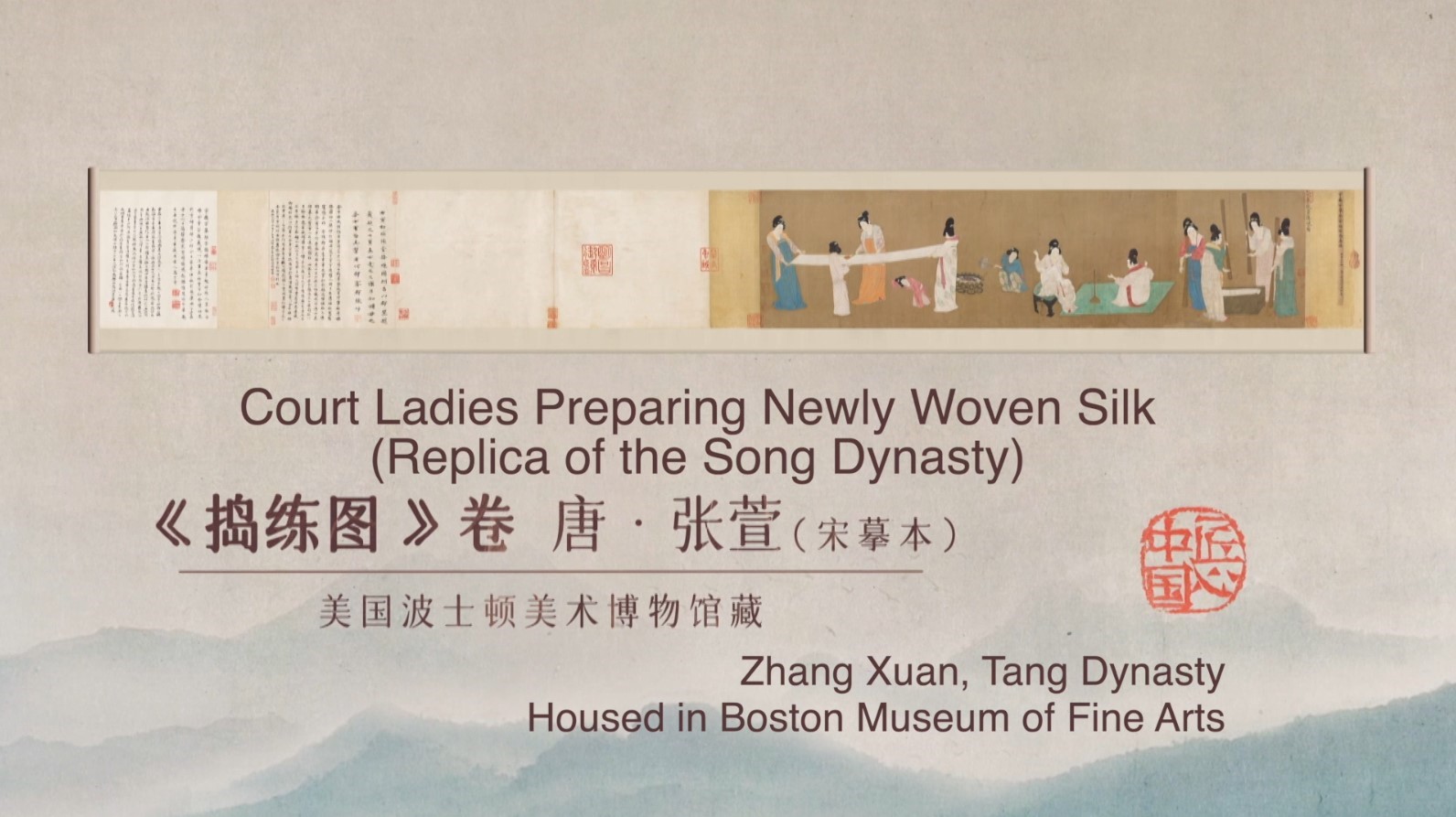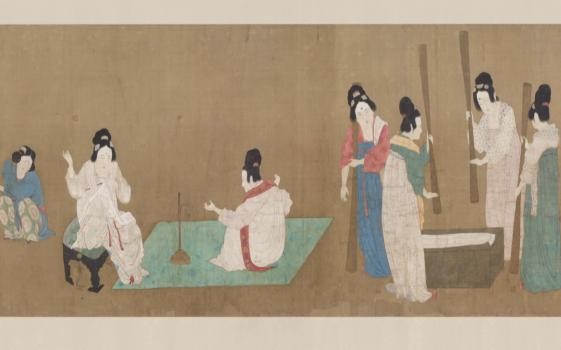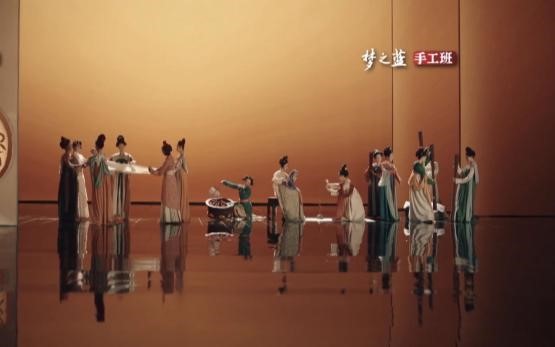In Chinese, "Dao" is a verb meaning "pound." "Lian" is a raw silk woven product with white color. In ancient China, the process of turning raw silk fabric into soft and lustrous cloth was called "Dao Lian," which was regarded as a fundamental activity for women comparable to men's agricultural work. Later, the activity became a poetic image, and was commonly seen in literati's works. Among all the related paintings, "Court Ladies Preparing Newly Woven Silk," by Zhang Xuan of the Tang Dynasty (618-907), is considered one of the best. It is an important painting of the Tang Dynasty, showing the scene of court ladies producing white silk. The 12 characters can be roughly divided into different groups doing one of the three procedures: pounding, sewing and ironing. Produced by China Media Group, the cultural program "China in Poetry and Painting" invited famous dancer Huang Lufei and dancers from the Xi'an Dance and Opera Troupe to adapt this masterpiece into a dance performance, bringing the court ladies of Tang Dynasty to life.
08:56

It is a pity that the original work by Zhang Xuan has been lost. The painting currently housed in the Boston Museum of Fine Arts in the United States, is a high-quality copy rendered in the Song Dynasty. The painting portrays three groups of luxuriously-adorned court ladies working on newly woven silk. Viewing from the right, the first group of four ladies are pounding silk with wooden poles. They are depicted standing in a diamond-shaped formation, thus creating a three-dimensional element. There are only two figures in the second group. Both of them are concentrating on the threads in their hands, one sitting on the ground preparing thread and the other sewing while sitting on a stool. Different from the dynamic beauty showed by the former group, the sewing ladies project a tranquil ambiance. On the left side of the scroll is the last scene of ironing. Three court ladies are stretching out a long piece of silk cloth, which is being ironed by another lady holding a wooden-handled metal spoon. A maidservant is fanning a charcoal stove for heating the spoon. And there is a naughty child scurrying around, looking around with interest, to playfully break the monotonous atmosphere of concentration, giving the painting a lively and lyrical touch.

A replica of Zhang Xuan's "Court Ladies Preparing Newly Woven Silk" /CGTN
A replica of Zhang Xuan's "Court Ladies Preparing Newly Woven Silk" /CGTN
In the Tang Dynasty, artists witnessed a flourishing economy and a stable society. Correspondingly, figure painting reached its zenith during the prosperous years, and branched into a new genre called "paintings of court ladies," which embodied the beauty of women. "Court Ladies Preparing Newly Woven Silk" is outstanding in its use of color. Zhang Xuan applied bright and warm colors to the ladies, echoing a magnificent and graceful aesthetic style that prevailed during the Tang Dynasty. In the painting, the 12 women are dressed in short tops, long skirts, and with shawls on their shoulders. The colors are different, yet blended and harmonized. The court ladies are elegant and plump, revealing the freedom, openness and tolerance of Tang society.

Details of a replica of Zhang Xuan's "Court Ladies Preparing Newly Woven Silk" /CGTN
Details of a replica of Zhang Xuan's "Court Ladies Preparing Newly Woven Silk" /CGTN
On the "China in Poetry and Painting" stage, as the lead dancer in red silk walks at a slow pace, a digital scroll of "Court Ladies Preparing Newly Woven Silk" gently unfurls itself. Accompanied by a melodious soundtrack, the 12 court ladies depicted in the masterpiece come to life through the dance performance. Through various expressions and postures, the dancers turn the cloth-making activities into elegant choreographic elements, reawakening the figures to the greatest extent. The blurred images of whirling dancers are like a kaleidoscope, reflecting the glory and the magnificent colors of the Tang Dynasty. Every twinkle and smile is bright, allowing the audience to take in the delight of the ancient fashion trends.

Dancers perform as the court ladies depicted in the painting. /CGTN
Dancers perform as the court ladies depicted in the painting. /CGTN
According to Wu Weishan, the curator of the National Art Museum of China, during the flourishing Tang Dynasty, Chang’an was the center of silk production in China. The prosperity can largely be attributed to women at that time, for whom making cloth was considered a proper occupation. "Court Ladies Preparing Newly Woven Silk" provides precious insight into women working at the ancient royal court. Thanks to their hard work, society was as prosperous as that depicted in the masterpiece. Today, when we look back to the Tang Dynasty and cherish the cultural legacy it left in history, we also look forward to the future, creating new works full of vitality and imagination.